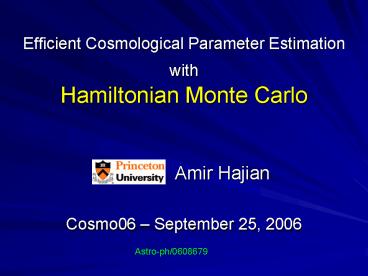Efficient Cosmological Parameter Estimation with Hamiltonian Monte Carlo
1 / 40
Title:
Efficient Cosmological Parameter Estimation with Hamiltonian Monte Carlo
Description:
Power Spectrum calculation takes a long time for large l. Likelihood takes time too ... with methods of speeding up power spectrum and likelihood calculations, ... –
Number of Views:68
Avg rating:3.0/5.0
Title: Efficient Cosmological Parameter Estimation with Hamiltonian Monte Carlo
1
Efficient Cosmological Parameter Estimation with
Hamiltonian Monte Carlo
- Amir Hajian
- Cosmo06 September 25, 2006
Astro-ph/0608679
2
Parameter estimation
NASA/WMAP science team
Fig. M. White 1997
3
The Problem
- Power Spectrum calculation takes a long time for
large l - Likelihood takes time too
- Lengthy chains are needed specially for
- Curved distributions
- Non-Gaussian distributions
- High dimensional parameter spaces
4
Possible Solutions
- Speed up the calculations
- Parallel computation
- Power Spectrum
- CMBWarp, Jimenez et al (2004)
- Pico, Fendt Wandelt (2006)
- CosmoNet , Auld et al (2006)
- Likelihood
- Improve MCMC method
- Reparametrization, e.g. Verde et al (2003)
- Optimized step-size, e.g. Dunkley et al (2004)
- Parallel chains
- Use more efficient MCMC algorithms,
- e.g. CosmoMC, Cornish et al (2005), HMC.
5
Traditional (Random Walk) Metropolis Algorithm
Current position
p(x)
6
Traditional (Random Walk) Metropolis Algorithm
Proposed position
p(x)
p(x)
p(x) gt p(x) accept the step
7
Traditional (Random Walk) Metropolis Algorithm
Proposed position
p(x)
p(x)
p(x) lt p(x) accept the step with probability
p(x)/p(x) Otherwise take another sample at x
8
Traditional (Random Walk) Metropolis Algorithm
9
Issues with MCMC
- Long burn-in time
- Correlated samples
- Low efficiency in high dimensions
- Low acceptance rate
10
Hamiltonian Monte Carlo
- Proposed by
- Duan et al, Phys. Lett. B, 1987
- Used by
- condensed matter physicists,
- particle physicists and
- statisticians.
- Uses Hamiltonian dynamics to perform big
uncorrelated jumps in the parameter space.
11
Hamiltonian Monte Carlo
p(x)
x
Define the potential energy U(x) -Log(p(x))
12
Hamiltonian Monte Carlo
U(x)
x
13
Hamiltonian Monte Carlo
U(x)
Give it an initial momentum
u(x)
x
Total energy H(x)U(x)1/2u2
14
Hamiltonian Monte Carlo
U(x)
Evolve the system for a given time Hamiltonian
dynamics
u(x)
u(x)
x
H(x) U(x) K(x)
15
Hamiltonian dynamics
H conserved, only if done accurately
16
Hamiltonian dynamics (in practice)
- Discretized time-steps
- Leapfrog method
Total energy may not remain conserved
Accept the proposed position according to the
Metropolis rule
?/2
?/2
u(t?) x(t?)
u(t) x(t)
u(t?/2)
?
17
Extended Target Density
Sample from H(x,u) Marginal distribution of x is
p(x)
18
How does it work?
- Assume Gaussian distribution
- Trajectories in the phase space
- Randomizing the momentum in the beginning of each
leapfrog guarantees the coverage of the whole
space
Fig. K. Hanson, 2001
19
Hamiltonian Monte Carlo
20
Important questions
- Are we sampling from the distribution of
interest? - Are we seeing the whole parameter space?
- How many samples do we need to estimate the
parameters of interest to a desired precision? - How efficient is our algorithm?
21
Convergence Diagnostics
Autocorrelation
22
Convergence Diagnostics
- Xi
- P(k) ?k2
FFT
?k
23
Convergence Diagnostics
- Power spectrum P(k)
- Averaged
Ideal sampler
Flat
24
Efficiency of MCMC sequence
- ratio of the number of independent draws from the
target pdf to the number of MCMC iterations
required to achieve the same variance in an
estimated quantity. - For a Gaussian distribution
- Where P0P(k0)
See Dunkley et al (2004) for more details
25
Example Gaussian PDFSampled with different
chains
Better efficiency
Low efficiency
26
Example
- Simplest example Gaussian distribution
- Energy
27
Comparison Acceptance Rate
HMC 100
MCMC 25
28
Comparison Correlations
29
Comparison distributions
30
Comparison Efficiency
Compare to 1/D behavior of the efficiency of
traditional MCMC methods
31
(No Transcript)
32
Cosmological Applications
33
Flat 6-parameter LCDM model
- 0th approximation
- Approximate
- the Lnlikelihood by
- Estimate the fit parameters from an exploratory
MCMC run. - Evaluate Gradients,
- Run HMC.
34
Result
- Acceptance rate boosted up to 81 while reducing
the correlation in the chain. - Good improvement, but can do better!
35
Better approximation for gradients
- Modified likelihood routine of Pico (Fendt and
Wandelt, 2006) to evaluate the gradient.
36
Lico (Likelihood routine of Pico)
F(x)
x
Cut the parameter space into pieces and fit a
different function to each piece.
37
The Gradient
38
Flat 6-parameter LCDM model
Acceptance rate 98
39
Correlation lengths
40
Summary
- HMC is a simple algorithm that can improve the
efficiency of the MCMC chains dramatically - HMC can be easily added to popular parameter
estimation softwares such as CosmoMC and
AnalyzeThis! - HMC can be used along with methods of speeding up
power spectrum and likelihood calculations, - HMC is ideal for curved, non-Gaussian and
hard-to-converge distributions, - Approximations made in evaluating the gradient
just reduce the acceptance rate, but dont get
propagated into the results of parameter
estimation. - It is easy to get a non-optimized HMC, but hard
to get a wrong answer!































